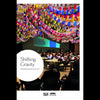Shifting Gravity
Pressedownload
Der Pressedownload darf nur im Zusammenhang mit einer Buchbesprechung verwendet werden. Für die Illustration einer Buchbesprechung können nur bis zu drei Bilder genutzt werden. Für andere Textformate und Nutzungszwecke (wissenschaftliche Vorträge, Werbung oder ähnliches) bitten wir Sie, vorab mit uns in Kontakt zu treten, um mögliche Fragen zu Honorarkosten, Nutzungsund Urheberrechten zu klären. Die bereitgestellten Bilddaten dürfen nicht manipuliert, beschnitten oder zweckentfremdet verwendet werden. Die Pressebilder dürfen nur mit dem vollständigen Bildtitel, dem Namen des Künstlers und/oder Urhebers sowie mit dem Hinweis auf den Hatje Cantz Verlag veröffentlicht werden. Bitte beachten Sie außerdem im Einzelfall die Reproduktionsbedingungen der VG Bild-Kunst Bonn bzw. der internationalen Verwertungsgesellschaften für Bildende Kunst.
Shifting Gravity
The rise in biennials worldwide over the past three decades—and most notably in Asia—provokes a shift away from the traditional centers of contemporary art and signifies a new cultural phenomenon that changes the way we understand the relationship between artistic creation, institutions, localities, and social relations. Biennials provide a platform for presenting contemporary art from the world over to a traveling group of art professionals, but more importantly to a wide public. Initiated by the Biennial Foundation and hosted by the Gwangju Biennale Foundation in South Korea, the inaugural World Biennial Forum investigated this multiplicity of new centers and gravities along with the heterogeneous practices in large-scale art shows today. This publication collects the presentations and discussions developed during the forum. Keynotes by eminent intellectuals on democracy, aesthetic representation, and cosmopolitanism help us conceive of biennials as an alternative space of political imagination. Case studies with a focus on Asia examine innovative and contextually relevant models of presentations of this kind in the Asia Pacific region. The contributions look back to the history of biennials, or investigate contemporary art’s relationship with other disciplines. Biennials featured (selection):Anyang Public Art Project, Biennale of Sydney, Chobi Mela, Emergency Biennale, Istanbul Biennial, Mediacity Seoul, Shanghai Biennale, Taipei Biennial, Tbilisi Triennial, Yokohama Triennial



